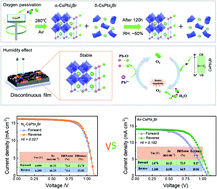All-inorganic halide perovskites (IHPs) hold promise in the field of optoelectronics due to their excellent thermal stability. However, the phase instability of these metastable structural polymorphs needs to be addressed. Here, a great deal of interest has been emerging to understand the phase (in)stability and report an additional stability mechanism of CsPbI2Br perovskite induced by both O2 and moisture in dry and high humid air to develop engineering strategies for making more robust IHPs. It is demonstrated that CsPbI2Br prepared in N2 experiences a sharp degradation as it is exposed to air (RH = 35%), while CsPbI2Br prepared in air shows much better long-term stability than that prepared in N2 atmosphere in both low (RH = 5–15%) and high humidity (RH = 30–55%) environments. The participation of O2 in the formation of perovskite crystals to form Pb–O bonds in the spin-coating process can prevent the transformation of CsPbI2Br from the α-phase to the δ-phase. In the presence of both oxygen and moisture, it is suggested that water can stabilize the reactive superoxide, which is formed by oxygen with excess electrons and enable them to spontaneously form additional Pb–O bonds with Pb before annealing. This can further stabilize perovskite under higher humidity conditions and improve the phase stability. This work presents a material design to develop IHPs in air with high stability.

